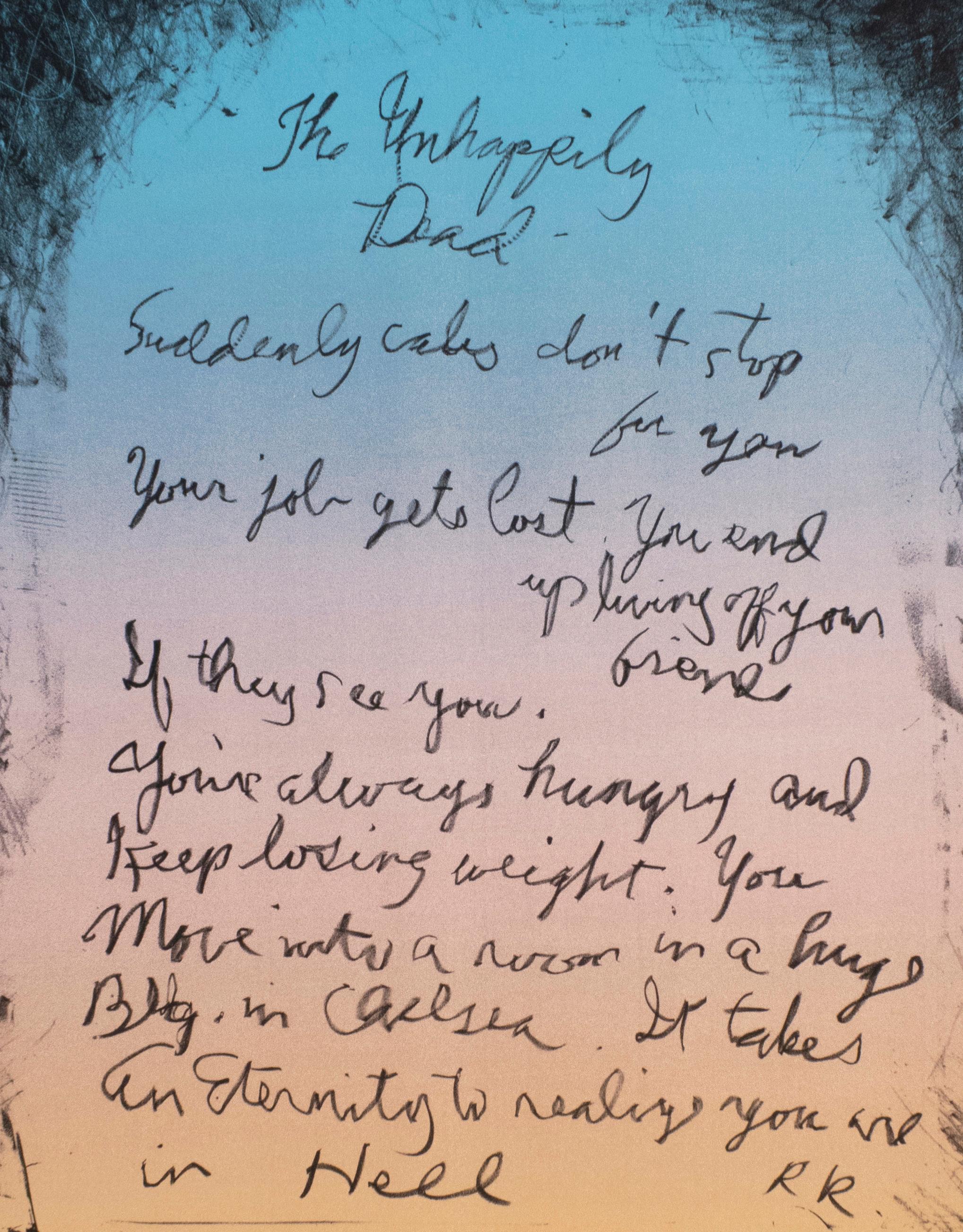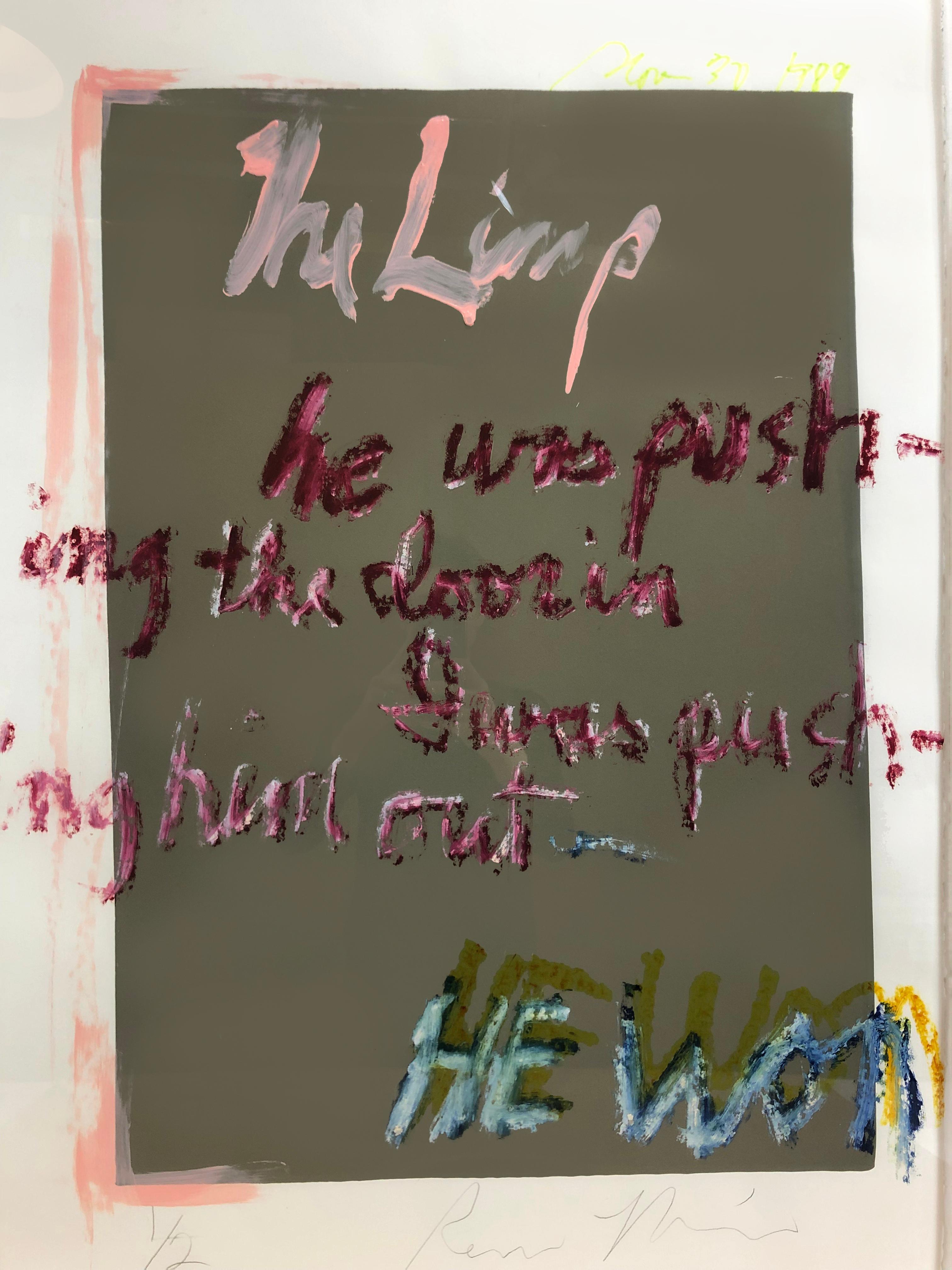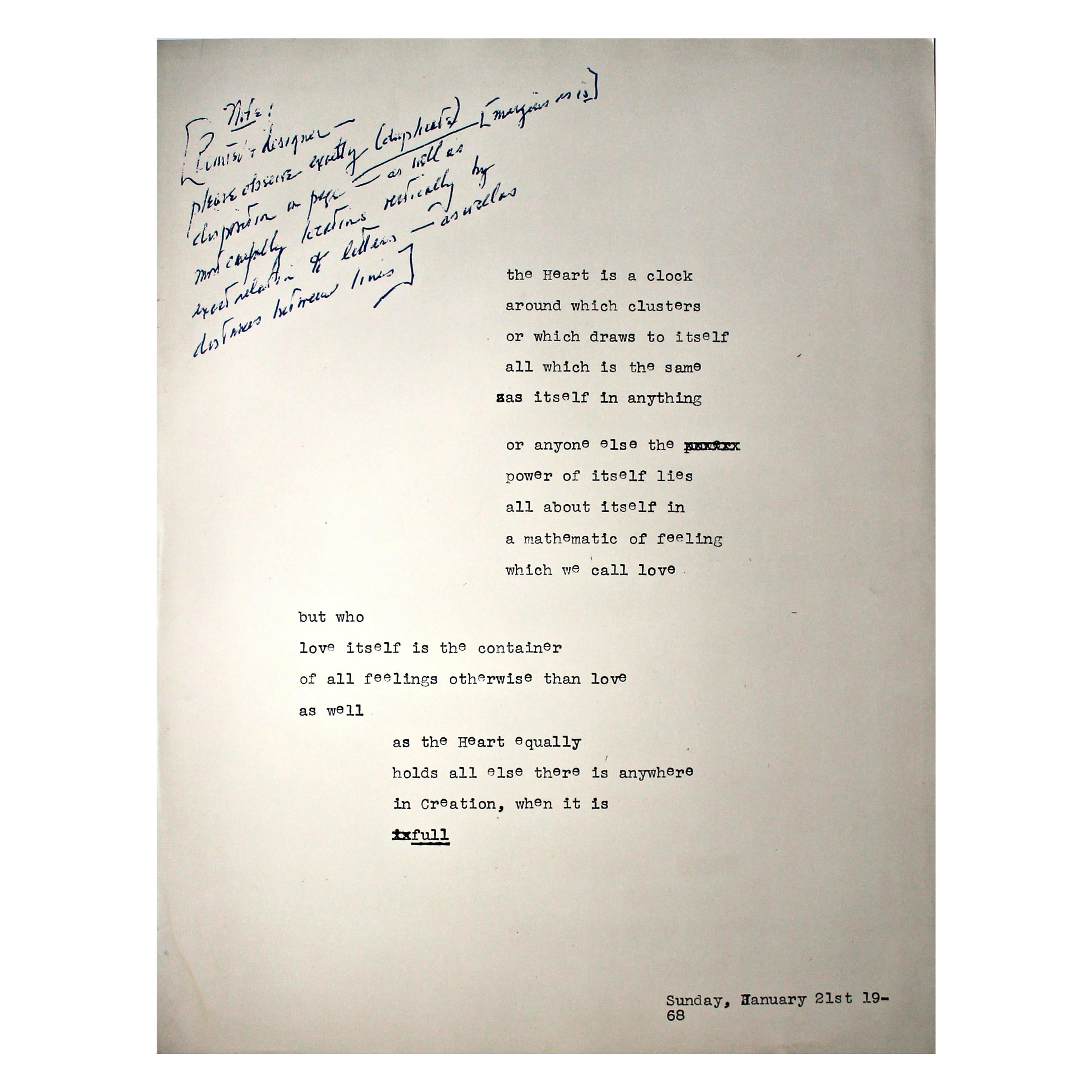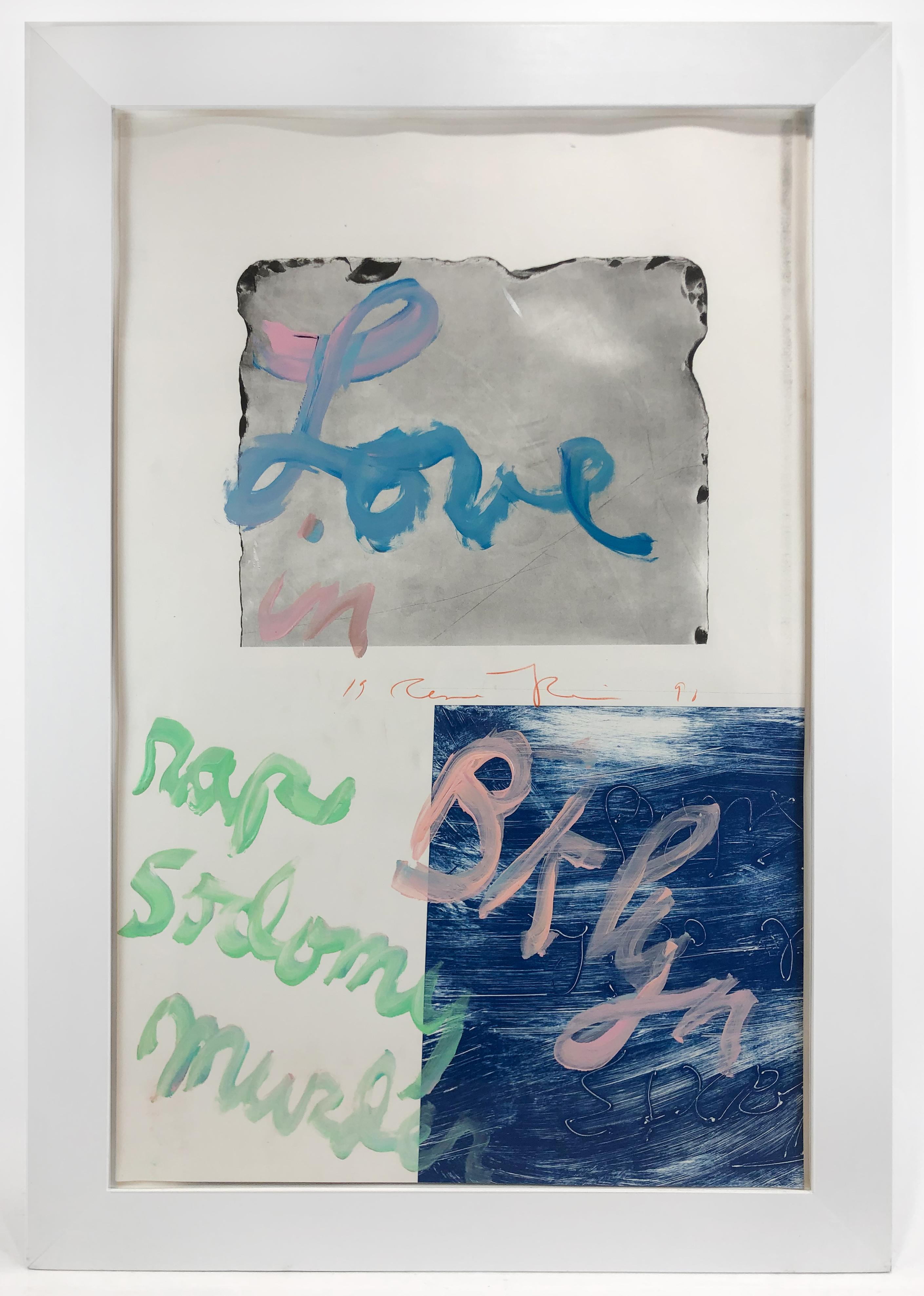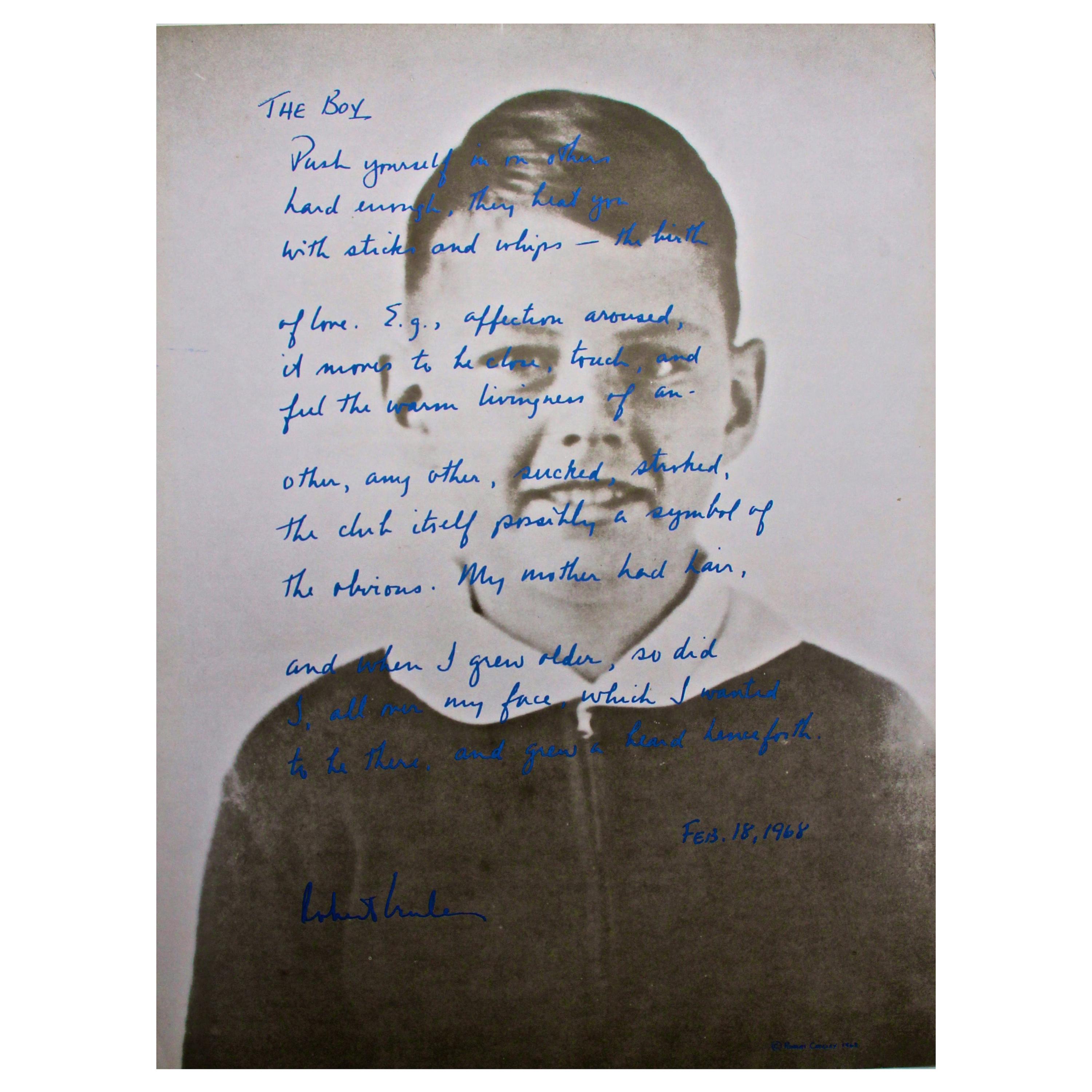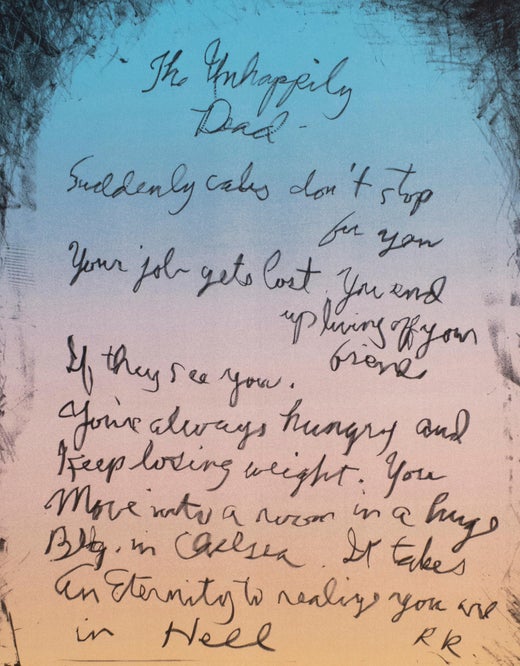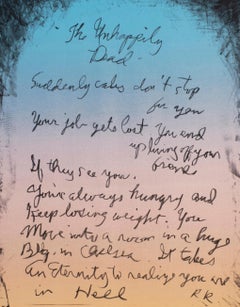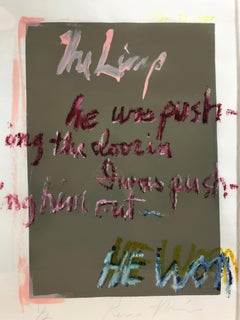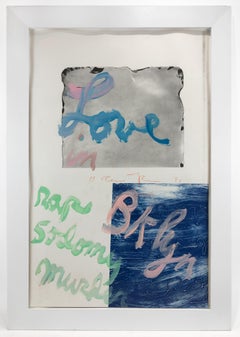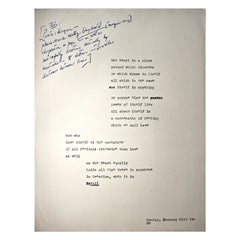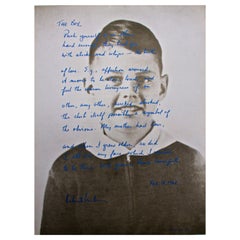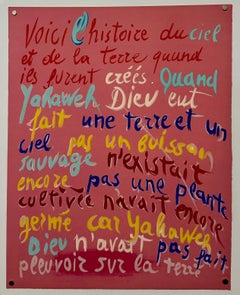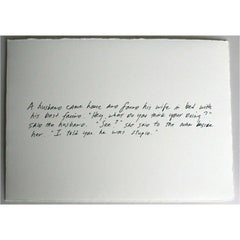Items Similar to David Shapiro: Rene Ricard vintage poetry tombstone print "carved in stone"
Want more images or videos?
Request additional images or videos from the seller
1 of 10
Rene RicardDavid Shapiro: Rene Ricard vintage poetry tombstone print "carved in stone"1989
1989
$1,850
£1,414.44
€1,620.58
CA$2,609.44
A$2,841.01
CHF 1,517.01
MX$34,295.47
NOK 19,071.53
SEK 17,738.74
DKK 12,104.92
About the Item
The title of this poetic, abstract work is written across the top of the sheet. The hand-written cursive below reads: "David Shapiro / Told me he was going to / Carve his poems in stone / "That's one way to make them lost" / I don't have to / Rene Ricard". A poet, art historian and art critic, David Shapiro was friends with Ricard, and a part of the 1980's art scene in New York. Shapiro became famous briefly during the 1968 anti-Vietnam student uprising at Columbia University, when a photograph of him smoking a cigar behind the desk of the Columbia University president was published in Life magazine, and he became the face of the student protest movement.
Ricard was a poet and art critic who published numerous books of his poetry, and his increasing use of text in his work over the 1980's reflects this interest in the written word. Here, Ricard playfully competed with fellow poet Shapiro, with Ricard signing his name across the lower center of the page -- having the proverbial last word over Shapiro. The frame surrounding the poem is the inked up edge of the lithography stone (heavy, limestone slabs used to print lithographs) upon which the artist inscribed his emotionally-expressive cursive. The printed shape of the stone recurs frequently in Ricard's work, here functioning as a pun ("carve his poems in stone") and as a memento mori, a gravestone bearing the two poets' names.
Paper 31 in. x 24.25 in. / 78.74 cm x 61.6 cm
Lithograph on German Etching paper. Edition 27. Signed by the artist lower right in red pencil; numbered in pencil lower left.
Ricard's confessional hand-painted and hand-written poetry is almost always accompanied by the artist's outsized signature, integrated into the composition, or placed at its center. In David Shapiro, Ricard signed his name in the plate, and again on the paper in red pencil, displaying the artist's unabashed confidence and flamboyance.
This confidence (and Ricard's bedroom-eyed allure) attracted the attention of Andy Warhol, and the young Ricard became his protege. He would appear in three Warhol films, even playing the Factory founder himself in "Andy Warhol Story". Warhol would later call the famously acid-tongued Ricard "The George Sanders of the Lower East Side, the Rex Reed of the art world."
By the early 1980s, Rene Ricard was a fixture in the New York art scene, not only as an accomplished artist, but as a critic. Penning enlightening and poetic essays for Artforum, he turned his attention to rising stars such as Julian Schnabel and Alex Katz. Ricard famously wrote the first major article on Jean-Michel Basquiat. “The Radiant Child” is credited with launching Basquiat’s career, and is considered a seminal contemporary art essay.
- Creator:Rene Ricard (1946 - 2014, American)
- Creation Year:1989
- Dimensions:Height: 31 in (78.74 cm)Width: 24.25 in (61.6 cm)
- Medium:
- Movement & Style:
- Period:
- Condition:This print is not previously owned and has been stored in the archives of the publisher since its publication.
- Gallery Location:New York, NY
- Reference Number:1stDibs: LU121125803812
Rene Ricard
Born Albert Napoleon, artist Rene Ricard moved to New York in the 1960s at the age of 18. With that relocation, Albert died, and Rene was born. Instantly adopted into Andy Warhol’s glittering orbit, Ricard thrived in the city, with its heady concentration of art, culture, and debauchery. He acted in underground films, playing Warhol in the artist’s own Andy Warhol Story, and was lauded by the New York Times in 1981 as “splendid” for his turn in the independent film Underground USA. He was a renowned art writer who launched the careers of artist like Jean-Michel Basquiat and Keith Haring with his poetic essays. In New York, Ricard found the center of his life. In his memoir “Rene Ricard” painter and close friend William Rand calls the artist “the Baudelaire of Avenue C…a brilliant, elusive and glamorous underground figure” adding that Rene’s stomping ground, the East Village, was a “…Halloween show all year round: squatters…hustlers, freaks…” Ricard could be found at any given time of day or night walking these streets, linking up with an endless stream of friends and acquaintances. The city’s underbelly was a bustling hub of culture: one could find artists, critics, gallerists and poets such as Nan Goldin, Julian Schnabel, Francesco Clemente, Bill Stelling, Jean-Michel Basquiat, and Allen Ginsburg mingling in the same gritty milieu. Like the rapidly-changing city, Rene's life was in flux: he moved between living situations and struggled intermittently with addiction, leaving a trail of makeshift canvases and alternately bleak, tender, and acerbic poetry. He had gained prominence and fame as an art critic and poet throughout the 1960s and 70s, but his nascent painting career took shape after gaining the attention of the Petersburg Press Gallery. They were to present his first exhibition in New York in 1990. The upcoming show proved to be a motivating force, harnessing Ricard's raw talent by providing him with studio assistants and a place to work at Petersburg’s studio on Lafayette Street. The show was to be entitled “Mal de Fin”. French for "Bad End", Mal de Fin may be a play on "fin de siècle": the end of an era and the beginning of another, and "mal du siècle": sickness of the century, a phrase attributed to the 18th/19th century French writer François-René de Chateaubriand. Chateaubriand’s notion of turn-of-the-century ennui no doubt resonated with the famously moody artist, and Ricard’s name change may have been inspired by Chateaubriand’s first name François-René. Mal de Fin’s body of work reflected not only his wild lifestyle, but the artist’s interest in spirituality, literature, and art itself.
About the Seller
5.0
Recognized Seller
These prestigious sellers are industry leaders and represent the highest echelon for item quality and design.
Gold Seller
Premium sellers maintaining a 4.3+ rating and 24-hour response times
Established in 1968
1stDibs seller since 2019
330 sales on 1stDibs
Typical response time: 1 hour
- ShippingRetrieving quote...Shipping from: New York, NY
- Return Policy
More From This Seller
View AllThe Unhappily Dead: Rene Ricard poetry of 1980s Chelsea New York life rainbow
By Rene Ricard
Located in New York, NY
Touched by the influence of Andy Warhol, champion of a young Jean-Michel Basquiat, Rene Ricard served as enfant terrible of the 1980s New York art scene. In this rainbow print, Ricar...
Category
1980s Contemporary Abstract Prints
Materials
Lithograph
$3,040 Sale Price
20% Off
The Limp by Rene Ricard abstract poetry painting
By Rene Ricard
Located in New York, NY
The Limp conjures the image of Rene consumed with energy and righteousness, then resignation: "He was pushing the door in, I was pushing him out / He won". The words are scrawled in ...
Category
1980s Abstract Abstract Paintings
Materials
Oil, Acrylic, Screen
Monet Portrait of Jeanne Duval: Ricard drawing vintage typewriter love poetry
By Rene Ricard
Located in New York, NY
Touched by the influence of Andy Warhol, champion of a young Jean-Michel Basquiat, Rene Ricard served as enfant terrible of the 1980s New York art scene. Here, Ricard traverses visual art, text, and the pleasure of sculptural trompe-l’œil with this printed drawing of melancholy hand-written and typed love poetry, composed with natural earthen shades of antique white and brown.
Monet Portrait of Jeanne Duval...
Category
1980s Contemporary Abstract Prints
Materials
Lithograph
Love in Brooklyn by Rene Ricard poetry painting
By Rene Ricard
Located in New York, NY
Love in Brooklyn, painted in baby blue, light pink, and pale green, depicts a stark image of Brooklyn, which had not yet seen the development spreading across Manhattan: “Love in Bro...
Category
1990s Abstract Paintings
Materials
Oil, Acrylic, Screen
Rene Ricard Red Blue Nasty, 1989 poetry painting Keith Haring reference
By Rene Ricard
Located in New York, NY
Frustration is center stage, written in cursive: "It's one of those days nothing works out right -- bump into any sharp corner – can’t tell flesh from white or brown from…or green fr...
Category
1980s Contemporary Abstract Paintings
Materials
Oil, Acrylic, Screen
Taxis, Rene Ricard lithograph of New York City life in grey blue with poetry
By Rene Ricard
Located in New York, NY
Lithograph on butcher paper. Signed lower middle of plate in blue pen. One of 21 signed, unnumbered lithographs, this impression is in gray/blue ink. In ...
Category
1990s Abstract Abstract Prints
Materials
Lithograph
You May Also Like
Rare Charles Olson/David Roth 'Poster Poem' of Black Mountain College Interest
By David Roth
Located in Sharon, CT
Charles Olson's "The heart is a clock" Poster Poem published 1968 by Edward Budowski (Aries Publications Buffalo N.Y.) in a numbered edition of 25-this i...
Category
Vintage 1960s American Minimalist Posters
Materials
Paper
Rare Robert Creeley/David Roth 'Poster Poem' of Black Mountain College Interest
By David Roth
Located in Sharon, CT
Robert Creeley "The Boy" Poster Poem published 1968 by Edward Budowski (Aries Publications Buffalo N.Y.) This from a rare series including: Allen Ginsberg, Louis Zukofsky, Charles Olson...
Category
Vintage 1960s American Minimalist Posters
Materials
Paper
Andre Lanskoy Dada Lithograph Mourlot Calligraphic French Poetry Brut Abstract
By André Lanskoy
Located in Surfside, FL
ANDRE LANSKOY (French / Russian 1902-1976)
1966
Original color lithograph on watermarked Arches paper
The title sheet was hand signed in pencil on the justification page by the arti...
Category
1970s Surrealist Abstract Prints
Materials
Lithograph
Richard Prince, The Greeting Card Jokes #2: The Best Friend, 2011
By Richard Prince
Located in Dubai, Dubai
Richard Prince, The Greeting Card Jokes #2: The Best Friend, 2011
Foil-stamped print, on heavy wove paper, folded.
As new condition, never framed or displayed. Hand signed and numbered by the artist, verso. Private collection (UK).
From a limited edition of 100.
Edition 91/100
6.25 x 8.5 in (15.9 x 21.6 cm)
Notes: Text image from Richard Prince's iconic Jokes series. Signed and numbered by the artist in ink on interior of card.
Incorporating jokes reflective of the “borscht belt” humor prevalent in the 1950's, Prince's Joke works tap into social preoccupations of the national subconscious. Prior to Prince's use of the jokes, many had infiltrated popular culture, gradually losing their original authors to become adopted by a largely oral tradition. Beginning in 1984, Richard Prince began assembling one-line gag cartoons and ‘borscht belt’ jokes from the 1950's which he redrew onto small pieces of paper. "Artists were casting sculptures in bronze, making huge paintings, talking about prices and clothes and cars and spending vast amounts of money. So I wrote jokes on little pieces of paper and sold them for $10 each". Following the hand-written jokes and subsequent works in which cartoon images were silk-screened onto canvas, in 1987 Prince adopted a more radical, formulaic strategy of mechanically reproducing classic one liners and gags onto a flat monochrome canvas. Richard Prince's work has been among the most innovative art produced in the United States during the past 30 years. His deceptively simple act in 1977 of rephotographing advertising images and presenting them as his own ushered in an entirely new, critical approach to art-making — one that questioned notions of originality and the privileged status of the unique aesthetic object. Prince's technique involves appropriation; he pilfers freely from the vast image bank of popular culture to create works that simultaneously embrace and critique a quintessentially American sensibility: the Marlboro Man...
Category
21st Century and Contemporary Contemporary More Prints
Materials
Archival Paper
Signed handwritten card: "PICASSO WOULD HAVE BEEN A GREAT ARTIST IN ANY AGE"....
By Carl Andre
Located in New York, NY
Carl Andre
Handwritten and hand signed card sent by the artist to his sister Joan Balerna, with original stamps and postmark
The card depicts an image of a Picasso work
On the front,...
Category
1990s Contemporary Figurative Prints
Materials
Postcard, Permanent Marker
Conceptual Artist Allen Ruppersberg Hand Printed Lithograph Prints & Photographs
By Allen Ruppersberg
Located in Surfside, FL
Allen Ruppersberg (American, 1944-)
Lithograph, Mixed media
From the Top Ten Historical Similarities (and Differences) Between Prints and Photographs.
This sale is of one print not t...
Category
2010s Conceptual Abstract Photography
Materials
Mixed Media, Lithograph
